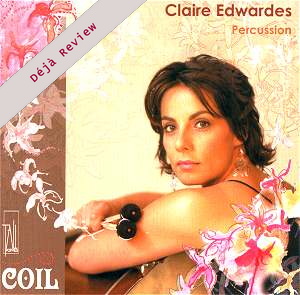
Déjà Review: this review was first published in July 2007 and the recording is still available.
Claire Edwardes (percussion)
Coil
rec. 2006, Recital Halls East and West, Sydney Conservatorium of Music, Australia
Tall Poppies TP193 [66]
I normally avoid percussion CDs like the plague, not because I don’t like percussion, but because the recorded experience invariably misses so much of the often spectacular visual element in the performance of such works. My main workplace, the Royal Conservatoire in The Hague, has an internationally recognized percussion department, and I had the pleasure of sharing a stage with Claire Edwardes a few years ago, having like her been shipped in to help out with one of those excellent composition projects in which few of the other students seemed to want to be involved. ‘The Seven Deadly Sins’ it was called – seven pieces based on some new bronze sculptures on that theme. I was delighted to see that Claire has been making a mark on the Australian contemporary music landscape since winning the ABC’s Young Performer of the Year in 1999 and the prestigious Freedman Fellowship in 2005. She has returned to Australia from studies and performances in Europe and is now involved in several new music ensembles in Australia as well as establishing herself as a soloist. This is her debut solo CD.
One thing you have to say about the programming of this disc is that there is plenty of variety. Seven composers each with a different approach to the incredible sound palette available to the contemporary percussionist, each using Edwardes’ admirable technique without losing their individual identity to the altar of pure virtuoso display. Gerard Brophy’s Coil is for vibraphone, and, with limited thematic content, has an attractive feeling of unity. Much of the melodic content is clipped into short segments, and the rhythmic character of the piece shows the vibraphone in a new light.
I liked Andrew Ford’s Memorial for cello solo, and while a piece for drum kit might seem a little daunting, his compact work The Armed Man has almost as much melodic interest as Brophy’s. The inevitable militaristic associations are created with the snare drum as a central element in the sound picture, but the opening tattoos serve merely as an introduction – the full range of bass, toms, hi-hat and cymbal create a fascinating solo as good as anything by Carl Palmer.
Ross Edwards’ More Marimba Dances are a follow-on from his earlier Marimba Dances, which has become one of the world’s most-played and most-loved percussion works. This second work contains all the qualities that made the earlier piece such a favourite with both performers and audiences alike. This kind of music is so well-written for the instruments that it sounds as if it must have been around for ages. This ‘classic’ feel with its easily assimilated themes and light, lively rhythms makes it easy to hear how such work is readily taken up.
With Andrew Schultz’ Winter Ground we return to the vibraphone, this time with more of an ethereal, sustained feel. Schultz actually uses the vibrato function of the instrument, which is quite refreshing to hear, and the piece is far from being vaguely atmospheric, with a set of variations exploring timbre and contrapuntal technique in some depth. Dominik Karski’s Beginnings to no end employs marimba and bongos, mixing the tuned and the untuned to interesting effect, even if the music itself has too much of a fragmentary feel to make it a huge success in my humble opinion.
Damien Ricketson’s Hol Spannen Luiden also employs the marimba as a central instrument, each word of the title being an individual movement: Hol = wood, Spannen = skin, Luiden = metal. He describes it as ‘a recollection, or a recounting, of a musical work where the original is never heard.’ There are some nice elements in these pieces, which I’m sure work well on an attractively presented stage, with the player focussed under a single spotlight. There are a few ‘hoketus’ moments where the composer might be alluding to the work of one of his teachers, Louis Andriessen, and the metallic nuances in the Luiden movement make for an interesting contrast in the programme as a whole. I just feel that these works are too long, given their actual musical content. I would recommend the Steven King formula ‘On Writing’, reducing by a third on the re-write.
The CD concludes with Mark Pollard’s two short Moment works for vibraphone, which have a gently minimal, almost Asian feel with touches of Javanese Gamelan and an attractive miniature quality.
The recording on this Tall Poppies release is excellent as usual, with the clean acoustic of the Sydney Conservatorium recital halls helping the instruments to glow and sparkle. Claire Edwardes is a marvellous advocate for her profession and this repertoire – much of which she helped to create by commissioning, cajoling and encouraging composers to take solo percussion seriously as an option for expressive new work.
Dominy Clements
Buying this recording via the link below generates revenue for MWI, which helps the site remain free.

Contents
Gerard BROPHY (b. 1953)
Coil (1996)
Andrew FORD (b. 1957)
The Armed man (2004)
Ross EDWARDS (b. 1943)
More marimba Dances (2004)
Andrew SCHULTZ (b. 1960)
Winter Ground (2000)
Dominik KARSKI (b. 1972)
Beginnings to no End (1999)
Damien RICKETSON (b. 1973)
Hol-Spannen-Luiden (1997)
Mark POLLARD (b. 1957)
Just a Moment (1996)
One Sweet Moment (1997)
















